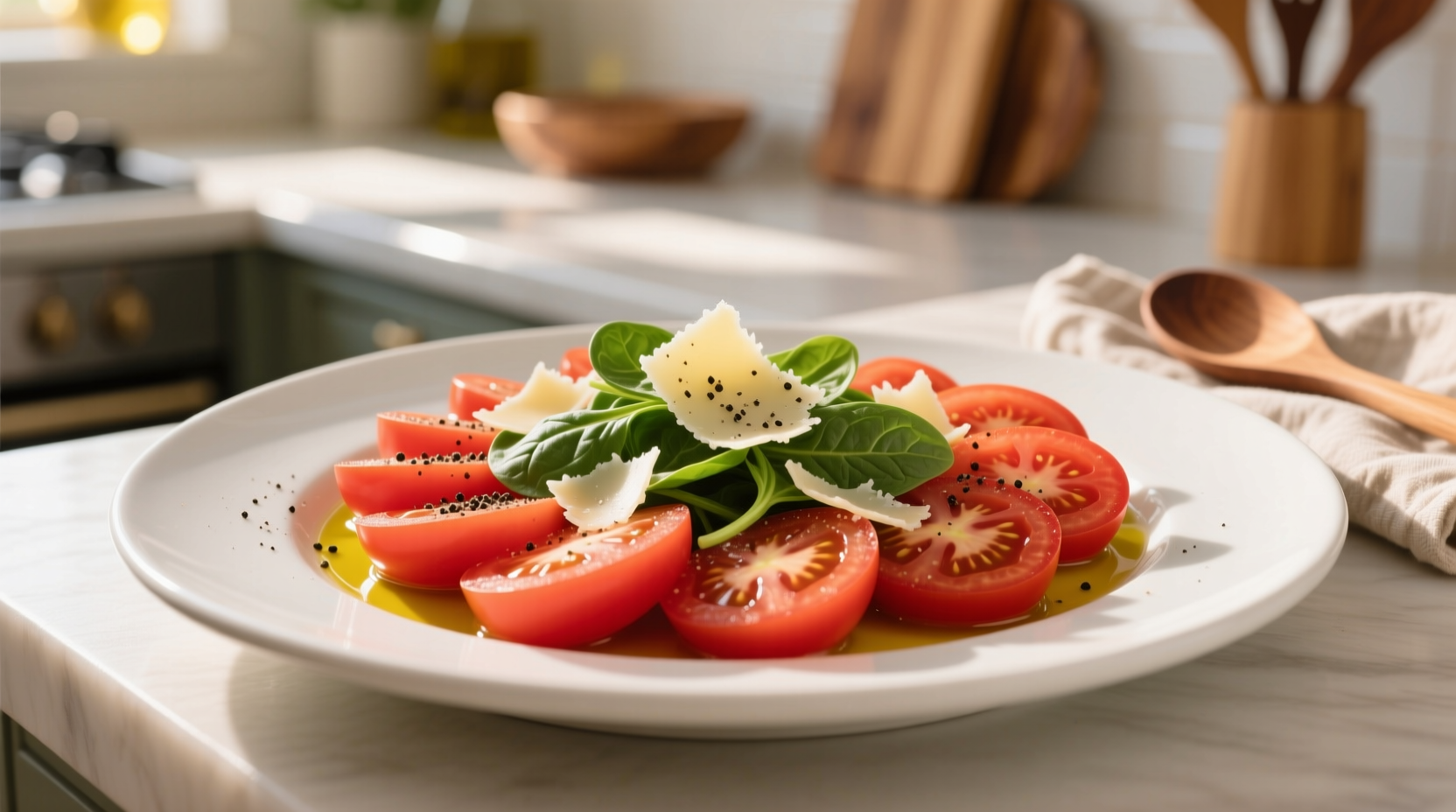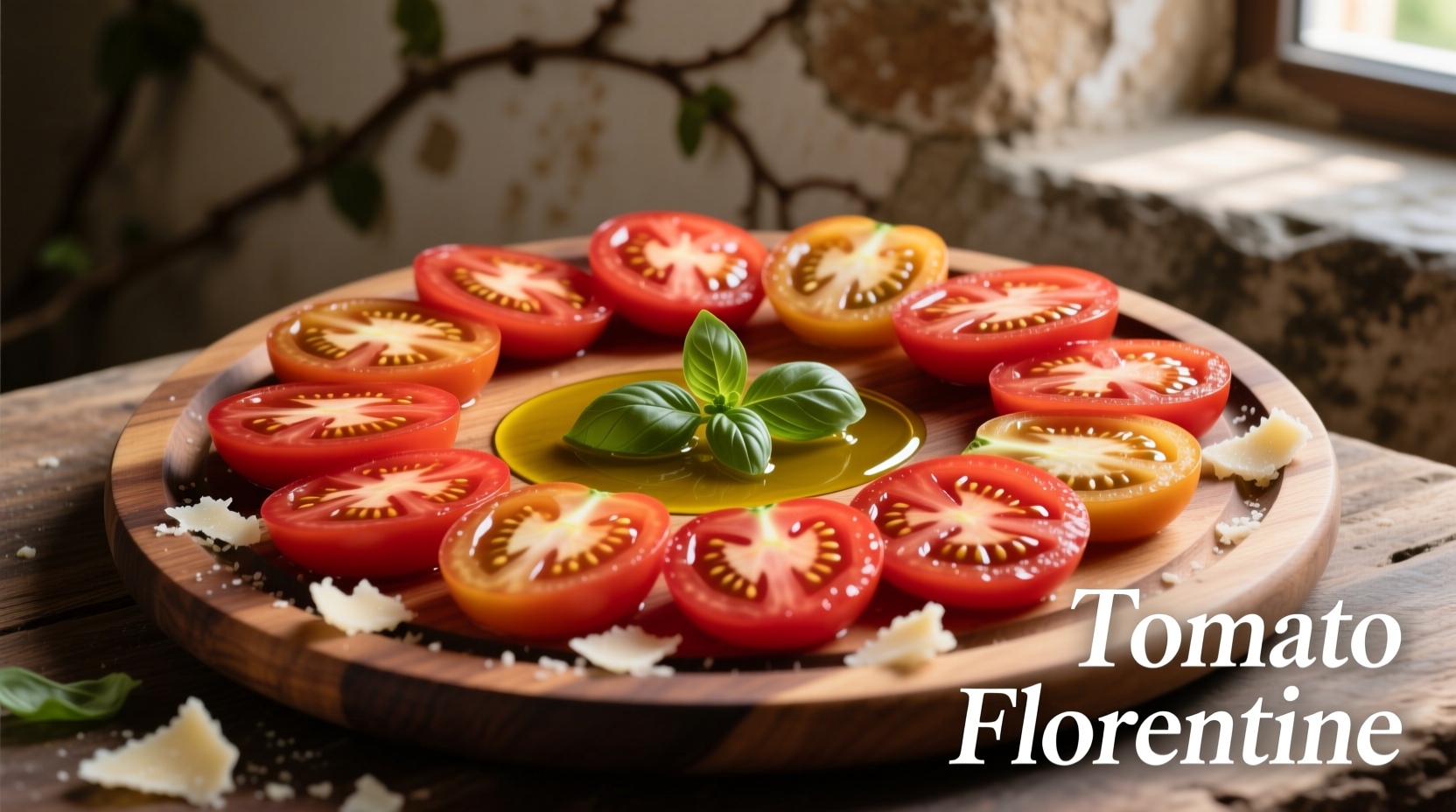What Makes Tomato Florentine Different From Other Tomato Dishes
While many tomato preparations exist, authentic Tomato Florentine follows specific culinary principles that distinguish it from simple tomato sauces or salads. The "Florentine" designation refers to cooking techniques originating from Florence, Italy, traditionally associated with dishes prepared à la Florentine—meaning with spinach, garlic, and olive oil.
Tomato Florentine adapts this classic preparation method specifically for tomatoes, creating a dish that's:
- Lighter than traditional tomato sauces
- Preserves the fresh character of ripe tomatoes
- Features a balanced garlic presence without overpowering
- Includes Parmesan cheese as a finishing element (not cooked into the dish)
The Evolution of Florentine Cooking Techniques
The term "Florentine" in culinary contexts has evolved significantly since its origins. Understanding this timeline helps appreciate Tomato Florentine's place in modern cuisine:
| Time Period | Key Development | Impact on Florentine Dishes |
|---|---|---|
| 16th Century | Introduction of tomatoes to Europe from the Americas | Tomatoes initially considered ornamental; not used in Florentine cooking |
| 18th Century | Tomatoes gradually accepted as food in Italian cuisine | "Florentine" referred exclusively to spinach-based preparations |
| Early 20th Century | Italian-American culinary innovation | Chefs began applying "Florentine" technique to other vegetables including tomatoes |
| Mid-20th Century | Publication of influential American cookbooks | Tomato Florentine recipes standardized in culinary literature |
| Present Day | Focus on seasonal, fresh ingredients | Tomato Florentine celebrated as a summer specialty using peak-season produce |
This culinary evolution explains why traditional Italian cooks in Florence might not recognize "Tomato Florentine" as an authentic regional dish, while it's well-established in international cuisine as a delicious adaptation of Florentine techniques.
Essential Ingredients for Authentic Tomato Florentine
The beauty of Tomato Florentine lies in its simplicity—few ingredients executed perfectly. Here's what you need to know about each component:
Tomatoes: The Foundation
Choose vine-ripened tomatoes at peak season (June-August in most regions). Roma tomatoes work well for their lower moisture content, while heirloom varieties add complexity. According to the USDA's Agricultural Research Service, tomatoes harvested at full ripeness contain up to 40% more lycopene than those picked green and ripened off-vine (ars.usda.gov).
Garlic: The Flavor Catalyst
Use fresh garlic cloves, not pre-minced. The key is gentle cooking—garlic should mellow but not brown. Food science research from the University of California shows that cooking garlic below 158°F (70°C) preserves more of its beneficial compounds while reducing harshness.
Olive Oil: The Flavor Carrier
Extra virgin olive oil isn't just fat—it's a flavor component. Look for oils with a harvest date within the past year. The International Olive Council notes that fresh olive oil contains higher levels of polyphenols, which contribute to both flavor and health benefits.

Step-by-Step Preparation Guide
Follow these professional techniques to create perfect Tomato Florentine every time:
Preparation Essentials
- Tomato selection: Choose tomatoes that are firm but yield slightly to pressure
- Prep technique: Core tomatoes and remove excess seeds/juice to prevent watery results
- Knife skills: Cut tomatoes into uniform ½-inch pieces for even cooking
Cooking Process
- Heat 2 tablespoons extra virgin olive oil in a skillet over medium-low heat
- Add 2-3 thinly sliced garlic cloves and cook until fragrant (about 1 minute)
- Add 2 cups prepared tomatoes, ¼ teaspoon salt, and a pinch of red pepper flakes
- Cook uncovered for 8-10 minutes, stirring occasionally, until tomatoes soften but maintain shape
- Remove from heat and stir in 1 tablespoon fresh lemon juice or red wine vinegar
- Finish with 2 tablespoons freshly grated Parmesan and 2 tablespoons chopped fresh basil
Common Mistakes to Avoid
- Overcooking: Tomatoes should retain some texture, not become sauce-like
- High heat: Causes tomatoes to release too much liquid and become mushy
- Adding cheese too early: Parmesan should be added off-heat to preserve flavor
- Using dried herbs: Fresh basil or parsley is essential for authentic flavor
Serving Suggestions and Creative Variations
Tomato Florentine's versatility makes it suitable for various occasions. Consider these serving options:
Traditional Pairings
- As a side dish with grilled chicken or fish
- Alongside roasted potatoes or polenta
- Served with crusty bread for dipping
Dietary Adaptations
- Vegan version: Omit Parmesan or use nutritional yeast for similar umami
- Low-sodium option: Reduce salt and enhance with additional herbs like oregano
- Gluten-free: Naturally gluten-free; verify all ingredients if serving to sensitive individuals
Creative Twists
- Add capers for a briny contrast
- Include artichoke hearts for additional texture
- Top with toasted pine nuts for crunch
- Drizzle with balsamic reduction for sweet-tart complexity
Seasonal Considerations for Tomato Florentine
Tomato Florentine is inherently seasonal. The dish shines when made with peak-season tomatoes, but you can adapt it year-round with these considerations:
- Summer (best season): Use garden-fresh tomatoes at room temperature
- Winter alternative: Roast cherry tomatoes with olive oil and herbs for concentrated flavor
- Off-season tip: When fresh tomatoes lack flavor, add 1 teaspoon tomato paste cooked with the garlic to boost umami
According to culinary research from the Culinary Institute of America, the sugar-to-acid ratio in tomatoes varies significantly by season, affecting final dish balance. Summer tomatoes typically require less acid adjustment than off-season varieties.
Frequently Asked Questions
Can I use canned tomatoes for Tomato Florentine?
Yes, but with adjustments. Use high-quality whole peeled tomatoes, drained well and patted dry. Reduce cooking time to 5-7 minutes since canned tomatoes are already cooked. Add ¼ teaspoon sugar to balance acidity, which is higher in canned products.
How long does Tomato Florentine keep in the refrigerator?
Properly stored in an airtight container, Tomato Florentine will keep for 3-4 days. The flavors often improve after 24 hours as the ingredients meld. Reheat gently over low heat to preserve texture—microwaving can make tomatoes mushy.
What's the difference between Tomato Florentine and tomato marinara?
Tomato Florentine is a lighter preparation with fresh tomatoes cooked briefly to maintain texture, while marinara is a cooked sauce where tomatoes break down completely. Florentine includes garlic and olive oil but no onions or extended simmering, resulting in a brighter, fresher flavor profile.
Can I freeze Tomato Florentine?
Freezing isn't recommended as tomatoes become watery and lose texture when thawed. The dish is quick to prepare fresh, making freezing unnecessary. For make-ahead convenience, prepare the components separately and combine just before serving.
Why is my Tomato Florentine too watery?
Excess liquid typically comes from not removing enough seeds/jelly or using under-ripe tomatoes. To fix watery Tomato Florentine, continue cooking uncovered until liquid reduces, or remove tomatoes temporarily while reducing the liquid, then return tomatoes to the pan.











 浙公网安备
33010002000092号
浙公网安备
33010002000092号 浙B2-20120091-4
浙B2-20120091-4